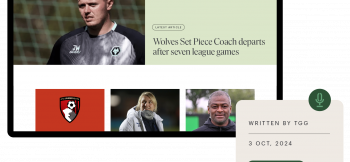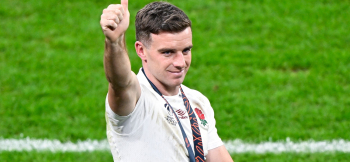TGG Podcast #25: Laurence Stewart - Rules of recruitment at Monaco

Stewart has worked for Monaco since June 2020
Written by Josh Schneider-Weiler and Simon Austin — April 8, 2021
LAURENCE STEWART was appointed as Monaco's Head of Recruitment and Development last June, with the club stating a desire to pursue the 'Red Bull model' of success.
The Englishman had worked for the Red Bull group for two years, latterly as their Head of Global Scouting, as well as for Manchester City, Everton and the Football Association.
When he arrived in the south of France last summer, Monaco were in the doldrums, having finished ninth and 17th in their previous two campaigns. Now, under the charge of Sporting Director Paul Mitchell (who arrived from Red Bull with Stewart last summer) and manager Niko Kovac - as well as an all-star backroom team - they are resurgent and competing for both the league title and French Cup.
In Episode #25 of the Training Ground Guru podcast, Stewart explained the key components of Monaco's recruitment strategy. You can listen via the player and also read an edited transcript of what he had to say below:
The role
Laurence Stewart: My main areas of influence are recruitment, so the scouting department, and performance analysis.
We also have ownership of a team in Belgium, Cercle Brugge, and my role is to support both teams. Cercle Brugge take their own decisions, but with recruitment we have a relationship and I help them. We aim to recruit and work in the same way and have similarity of concept across both teams.
Cercle Brugge give a good opportunity for player development and growth and we see a lot of high-value players coming out of the Belgian league. We have a number of players on loan there this season and they’re the second youngest team in Belgium in terms of on-pitch minutes.
It’s the beauty of a multi-club model - you can put those principles in all your clubs and speed up the learning of your players if they move between clubs.
When we came to Monaco last summer the club had had two disappointing seasons, with ninth and 17th place finishes, so there was a real desire to improve the performance of the team.
When we arrived we tried to understand the current processes, the ways of working and the individuals, and then went about formulating how that aligned with the way we wanted to work, where it differed and what steps we could take.
We made investment in certain areas - scouts, performance analysis, the tools we use, data, information - to be able to work in the way we wanted.
There are many different ways to do this role. I have a certain history and have been on a certain personal development, so I have had more exposure to certain principles, like data, right back from my performance analysis days. I am very comfortable with understanding data and also its weaknesses, so where are the blind spots, so you don’t fall into any traps.
There are certain things you’re also weaker in and you support yourself with good people who can deliver some of those topics for you. It’s about being open-minded to understanding where and how certain things can be used.
Underlying principles
The biggest thing initially is understanding the ambitions of the organisation and the underlying principles you believe will help you to deliver them.
For Oleg Petrov (Monaco CEO) and Paul Mitchell (Sporting Director), that was their discussion with the ownership, to say: ‘This is the strategy we want to work towards, this is the ambition we have for the club, and these are our beliefs about how we can deliver against those objectives.’
My role sits underneath that, so within my remit I had to work out how those principles transferred into my areas of work and how we can make sure we are working in a way that can support and deliver to those principles.
If that’s a certain playing style, then we need to make sure our recruitment and analytical processes are collecting the correct measurements to be able to work against that. If we are looking to reduce the age of the playing squad, then we need to be set up recruitment-wise to be able to deliver profiles that sit within that bracket.
It’s the same financially - we have to understand the financial mechanisms the club will have available and where it will operate.
Player profile
The way we want the team to play is to be dynamic, athletic and to have high intensity, both with and without the ball.
We also want to be a technically skilled team and protagonists with the ball, because we will face a lot of matches where we are ball dominant and need players that can deal with those situations. We want to carry some of these principles over to Cercle Brugge as well, so there is similarity of play.
Organisations and teams have different playing styles, which is what makes football exciting.
One thing that will naturally happen is that the game will get quicker. If you look at most elite sports, they’re increasing in speed, tempo, collisions and impacts, and that’s because of the heightened athleticism of the players.
If you look at last summer, we recruited Krepin Diatta, Caio Henrique, Axel Disasi, Kevin Volland, Florentino Luis and goalkeeper Vitor Mannone.
Kevin was an experienced player who we thought could bring very good leadership and performance to the group. The other outfield players all sat within that younger profile of players we’re looking for; they have growth and room for development, but enough level of experience to be able to perform for the team.
Josh asked Laurence about the messages he has pinned to the wall of his office and he read two:
1. "The most dangerous phrase in the language is ‘we’ve always done it that way’."
2. "We must ground our work in a rich understanding of the context of use, or else we run the risk of creating well-meaning rubbish."
We want to be back in European competition and to be competitive in the league, so there is a consideration of squad balance. That will have a large element of young talent, because that’s one of our core principles, but we also want to support that with experienced players.
For our young players to grow and develop, there needs to be some stability around them and some of that does come from experience, so we want to try and get the balance right.
Knowing about young players as early as possible
With somebody like Krepin Diatta (pictured below), we felt he sat very well within our profile of recruitment and that the January window was the optimum time for us to secure him, because the way we were seeing his development and growth, he may have very rapidly progressed out of our financial bracket.
Obviously I moved organisations last summer, but Krepin was somebody we had been tracking previously. There’s a minimum period of work there of two plus years in terms of that particular player.

If we want to be a club that recruits that type of profile, we have to know about young players as soon as possible and data is key in that early identification stage.
Who are the young players getting playing minutes? Who are the young players making debuts? Do we know about them? If we don’t, then we need to start doing some work on them.
That’s one of your fundamentals. If you want to recruit young players, you need to know those guys. Data can allow us to focus our resources on certain players and we will do research on certain clubs that we think are good producers of talent within their regions, so we can be focused and know exactly where to look.
Recruitment process: Identification, monitoring & detailed analysis
We go through a range of processes.
At the beginning, there’s an initial identification stage, which is finding players that can fit inside the profile we want, through to more detailed monitoring, where we look at that player in different situations, to be able to layer the context we need into our assessment.
As we go through that process, we are always layering more data into our assessment, whether that’s technical profile, tactical, physical. It’s common throughout our whole process now really, data.
Then there's a detailed analysis, which involves comparisons to other players, either internally or externally. In the final stage we go into more depth, trying to understand the risk of signing this particular player and then trying to manage that before making our final decisions.
Data
Data comes in throughout this process at different junctures. Every decision we make is based on a large amount of data and analysis before we arrive at our final decisions.
Tyler (Heaps, Monaco's Head of Sporting Technology and Insights) is building all our dashboarding and algorithm processes. We have certain things we look for that are important for us and build them into our data assessment and hopefully that can push us in certain directions.
Tyler has got this great knowledge of all the different data and tech that’s out there in the market. We want to use the relevant resources for us, so we have to make decisions on one data provider over another, one visualisation tool over another, so Tyler brings a great level of knowledge into that process.
And he lives with data every day. So he’s a guy who can really get into the detail and bring his own ideas, in terms of perhaps metrics we could be looking at, combinations of metrics.
I might bring some, other members of the staff might bring some of these ideas too, and he can then start to action some of those and we can challenge it and try to find the correct metrics that we believe will be consistent over time and help us make better decisions.
Data’s blind spots
Technical data is the most prominent data set we use, but there are still certain areas for development within that. Perhaps it doesn’t shine so much light on the decision-making process of a player; it doesn’t always inform you about the options of that player, it’s more outcome based.
Certain positions lend themselves to better technical profiling than others. You have positions where there’s an element of volume required, like central midfielders, where there’s a level of outcome base you can use and data can collect that information.
But there’s still this classic discussion point around central defenders - that a well-positioned and intelligent central defender should never have to make a tackle, because they’re getting there before they need to. So how do we manipulate that into our assessment?
Even for strikers, you have ones who want to run in behind. How well can certain data sets tell you about that? Not always really clearly, so you still need to add that layer of context.
Video v live eyes
We always try to cover all our bases, with data, video and live scouting.
A player can be found by any of those mechanisms, but for me then they’re in the same system and will go through the exact same processes of scrutiny. We will look at a player the same amount of times on video, we’ll watch them the same amount of times live.
I don’t think there’s a magic number in terms of seeing a player live. I think there are perhaps some things you have to see live to have the comfort required to be able to say 100% 'that is the player for us,' so, for me, there is still the requirement to go live.
Again, that might be different for different organisations. I know some will use a huge amount of video. Because of covid, we’ve missed certain things by not being able to attend games live.
There are certain things that are more difficult on video, because you only get a certain view at any one time. The TV camera is moving with the ball, so a certain player in a certain position might be off camera and you’re not seeing his behaviours and actions. Is he displaying the behaviours you want from that particular position? It might be recovery runs, his communication with his team-mates, his respect for officials.
One of our challenges moving forward is, when we do go live, establishing what are the things that we can only collect live and then making sure we absolutely nail them. And when we’re on video, what are the things we are comfortable we can assess and make sure we cover those too. Let’s not repeat processes across all the different mechanisms, let’s piece it together.
Scouting a player’s character
This is still one of our biggest areas for development.
What does a player represent as an individual? What do they represent as a team-mate? And are these the principles we look for?
When we get the opportunity to see a player live, in full view for 90 minutes with a warm-up as well, what information can we take from that to also form a picture of that player as a person and character as well?
Everybody knows social media is out there, as well as social media profiling, but can we go deeper to look at the traits of an individual, to the way they talk consistently? Perhaps they’ve done interviews and certain pieces to media and there are traits you can get out of that.
They’re all interesting areas and topics for development because, unlike other sports, we don’t get the opportunity to sit down and interview players and do face-to-face. In football, that’s not the way it operates, so you’ve always got that element of how will the individual adapt to our environment and ur building.
Again, if we can try and get information to reduce the risk of that not being successful, then it’s what we have to do.
People will be true to themselves over time, so you’ll see their core traits. I watched, not too long ago, the Netflix series Mindhunter. They were interviewing serial killers in death row in prison. They record and catalogue everything and within the way that person speaks or writes they are looking for certain characteristics.
That gets you thinking. We don’t get all of those opportunities, but we can be better than we have been at understanding that and some information is better than none, with the right context.
Coach surveillance
For the Sporting Director, he needs to have a global perspective of the coaching landscape. If we look at Niko Kovac, he was someone we had an understanding of because of our experience within Germany.
When we did profiling of the attributes that his teams showed on the pitch, they fitted very well with how we want the team to play here. He was a natural fit and is doing very well this season.
I’m sure Niko will be a coach other people will want at some stage if he continues to do so well, so we have to have an understanding of other teams and coaches that are showing some of those similar principles.
If we look at the principles we have referenced in terms of how we want our team to play - to be high tempo, pressing high up the pitch, showing an attitude to counter pressing and being dynamic in how we move the ball - they’re all factors we can build into our coach surveillance as well as our player recruitment.




-1.png)





